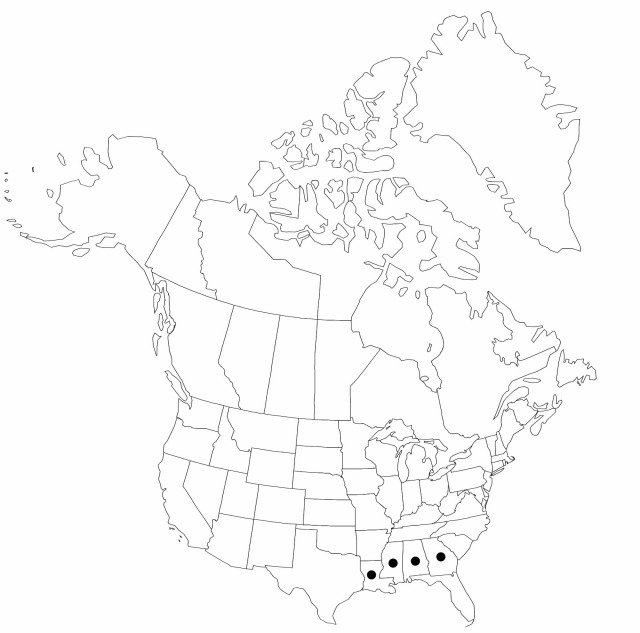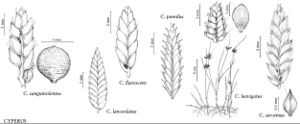Difference between revisions of "Cyperus sanguinolentus"
Enum. Pl. 2: 351. 1805.
FNA>Volume Importer |
FNA>Volume Importer |
||
| Line 11: | Line 11: | ||
|name=Cyperus louisianensis | |name=Cyperus louisianensis | ||
|authority=Thieret | |authority=Thieret | ||
| − | }}{{Treatment/ID/Synonym | + | }} {{Treatment/ID/Synonym |
|name=Pycreus sanguinolentus | |name=Pycreus sanguinolentus | ||
|authority=(Vahl) Nees | |authority=(Vahl) Nees | ||
| Line 29: | Line 29: | ||
|elevation=20 m | |elevation=20 m | ||
|distribution=Ala.;Ga.;La.;Miss.;Asia;Africa. | |distribution=Ala.;Ga.;La.;Miss.;Asia;Africa. | ||
| − | |discussion=<p>Cyperus sanguinolentus is the only rhizomatous, distigmatic Cyperus in the eastern United States. An early collection from Louisiana was described as C. louisianensis, supposedly endemic. Recent field work and morphometric studies convincingly showed it to be an introduction of the Asian C. sanguinolentus) (J. R. Carter and C. T. Bryson 2001.</p> | + | |discussion=<p><i>Cyperus sanguinolentus</i> is the only rhizomatous, distigmatic <i>Cyperus</i> in the eastern United States. An early collection from Louisiana was described as C. louisianensis, supposedly endemic. Recent field work and morphometric studies convincingly showed it to be an introduction of the Asian <i>C. sanguinolentus</i>) (J. R. Carter and C. T. Bryson 2001.</p> |
|tables= | |tables= | ||
|references={{Treatment/Reference | |references={{Treatment/Reference | ||
| Line 57: | Line 57: | ||
|publication year=1805 | |publication year=1805 | ||
|special status= | |special status= | ||
| − | |source xml=https://jpend@bitbucket.org/aafc-mbb/fna-data-curation.git/src/ | + | |source xml=https://jpend@bitbucket.org/aafc-mbb/fna-data-curation.git/src/8f726806613d60c220dc4493de13607dd3150896/coarse_grained_fna_xml/V23/V23_257.xml |
|genus=Cyperus | |genus=Cyperus | ||
|subgenus=Cyperus subg. Pycreus | |subgenus=Cyperus subg. Pycreus | ||
Revision as of 16:06, 18 September 2019
Herbs, perennial; rhizomes ± horizontal, to 12 cm × 0.8–1.2 mm. Culms ± terete to roundly trigonous, 3–25(–60) cm × 0.3–2 mm, glabrous. Leaves 1–3, V-shaped, 1–8(–15) cm × 1–2 mm. Inflorescences: spike 1, loosely ovoid, 7–14 × 8–20 mm; rays (0–)1–4, to 2(–3) cm; bracts 2–4, horizontal to ascending at 30(–45)°, V-shaped to flat, 1–8(–18) cm × 0.5–1.5(–2) mm. Spikelets 3–5(–14), oblong to linear-lanceoloid, 8–18 × 2–2.6(–3) mm; floral scales (6–)10–26(–32), laterally clear to light brown, sometimes with purplish margins, medially light brown, 2-keeled, laterally ribless, medially 2–3-ribbed, oblong to ovate, 1.9–2.2(–2.7) × 1.8–2.3 mm, apex obtuse. Flowers: stamens 3; anthers ellipsoid, 0.3–0.6 mm, connective not prolonged; styles 0.6–1 mm; stigmas 1–1.5 mm. Achenes brown, ± stipitate, obovoid to ovoid, 1–1.4 × 0.6–0.8 mm, apex truncate, apiculate, surfaces minutely punctate.
Phenology: Fruiting late summer–fall.
Habitat: Emergent shorelines, ditches
Elevation: 20 m
Distribution

Ala., Ga., La., Miss., Asia, Africa.
Discussion
Cyperus sanguinolentus is the only rhizomatous, distigmatic Cyperus in the eastern United States. An early collection from Louisiana was described as C. louisianensis, supposedly endemic. Recent field work and morphometric studies convincingly showed it to be an introduction of the Asian C. sanguinolentus) (J. R. Carter and C. T. Bryson 2001.
